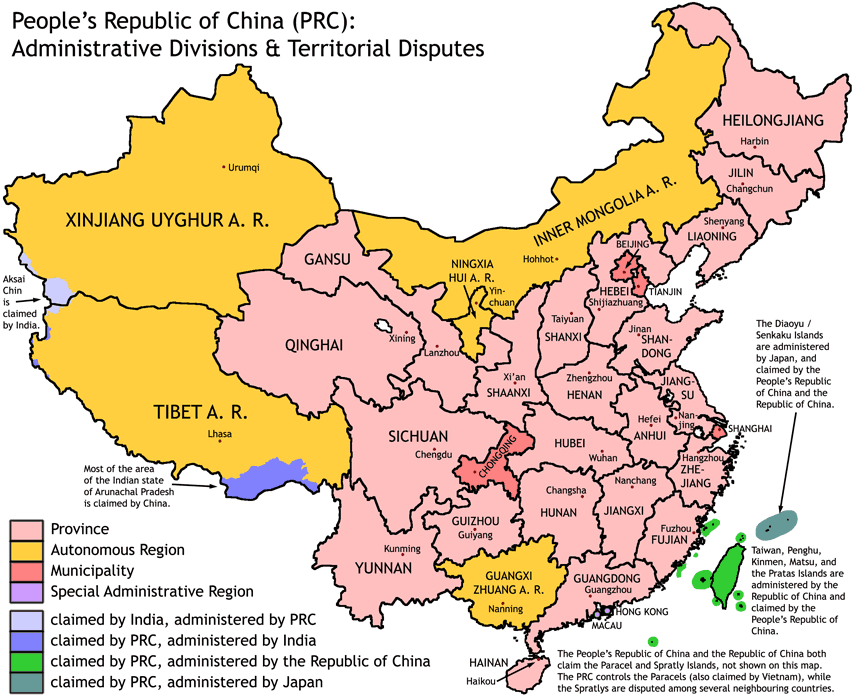Introductory Map Terms
Here are some key words and meanings to better understand China and its geographic locations.

-
Bei — North
Nan — South
Dong — East
Xi — West
Other key geographical terms:
-
Jing — Capital City
Shan — Mountain
Hu — Lake
He — River
Jiang — Great River
Capital Cities
Beijing and Nanjing have been the traditional capital cities of China, i.e., the north and south national capitals (jing). However, in ancient times, Japan was regarded as a further extension of Chinese culture and language such that Tokyo is still known in both Chinese and Japanese languages as Dongjing, the eastern capital. Meanwhile, Xi’an, located in west-central China was the early capital of the Qin Dynasty (221-210BC) that brought the first unification to China. (It is here that we find today the famous Terracotta Warriors which were installed to guard the tomb of first emperor Qin Shi Huang). By some accounts, the name of the Qin Dynasty, where qin is pronounced like “chin” gives rise to the name for China, but this is widely disputed. But Xi’an is famous as a historical gateway to the so-called “Silk Roads” trade routes.
Landmark Key Terms
Rivers (he and jiang), lakes (hu), and mountains (shan) were major landmarks. These words have been used from early times to name cities and regions. We could also add here the sea (hai), which is part of the name of Shanghai, where the great Yangtze River (Changjiang) empties into the Pacific.
The Mandarin word for a great river is jiang, and it appears in the names of numerous cities and provinces in the region of the Yangtze River (known to the Chinese as Changjiang). Note the locations of Jiangsu, Jiangxi, and Zhejiang as the river approaches the sea.
North and South Provinces
Two major provinces in north-central China are Hebei and Henan, i.e., north and south of the river (he), the Yellow River (Huanghe).
Likewise, two major provinces in south-central China are Hubei and Hunan, i.e., north and south of the lake (hu), in this case, Dongting Hu, one of the largest lakes in China.
East and West Provinces
We have two major provinces located in north central China on either side of the Taihang mountain range. From the word for mountain (shan) we get the names Shandong and Shanxi as provinces to the east and west.
In the far south of China, we have similar naming of provinces to the east and west of something called guang, the meaning of which is a bit more obscure. Just a few centuries ago, Huguang (meaning “beyond the lake”) was a large province in the region of Dongting, including Hubei, Hunan, and extending further to the south (Guangnan), the latter of which became divided with Guangdong to the east, and Guangxi to the west.
The North-East of China… Old Manchuria
Another interesting part of China is the Dongbei area. Can you guess? It is, logically, the North-East (or, as the Chinese say, the “east-north”) part of China. It gives rise to another set of Chinese words that come from the people of this area.
The Dongbei area was the home of the Qing people who ruled China during the Qing Dynasty (1644-1911). Later overrun by foreigners, first the Russians and then the Japanese, this area became known as Manchuria– the home of the Man people. Installed as rulers of China in Beijing during the Qing Dynasty, we foreigners chose to name these officials the Mandarins.
Foreign Words for Chinese to Learn
The specific dialect of these Beijing officials has now become known as the official Mandarin language. Don’t be surprised, however, if the word Mandarin needs to be explained to the Chinese people themselves. It is not a common word in their own language. What we call Mandarin is, for Chinese people, Putonghua, the People’s Language.
The specific dialect of these Beijing officials has now become known as the official Mandarin language. Don’t be surprised, however, if the word Mandarin needs to be explained to the Chinese people themselves. It is not a common word in their own language. What we call Mandarin is, for Chinese people, Putonghua, the People’s Language.
In a similar way, and very surprising to a many people, the country name, China, is not really the name Chinese people use for their own country. Their homeland is Zhong Guo, which means “Middle Kingdom” or “the Middle Plains.” (It is similar to the case of Westerners naming the sea between Europe and North Africa as “Mediterranean” meaning “Middle of the Earth”.)
Enjoy Learning Chinese
This approach to learning a bit of Chinese was exceedingly practical for me. Maybe this can be an early lesson in Chinese for English speakers, with just a bit of history also thrown in.
Remember to tap the map above to view in larger format.
First published: 2020/02/24
…